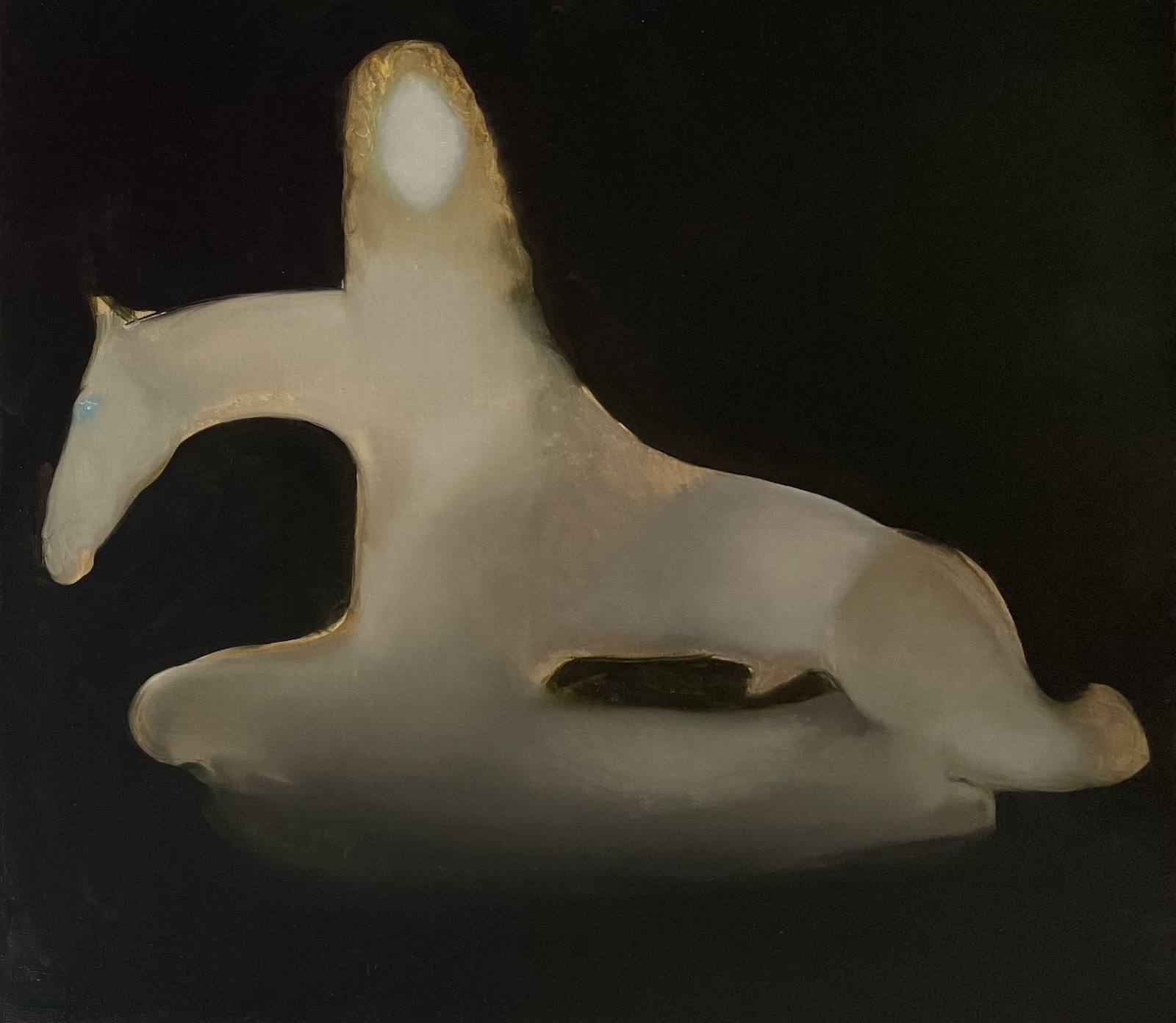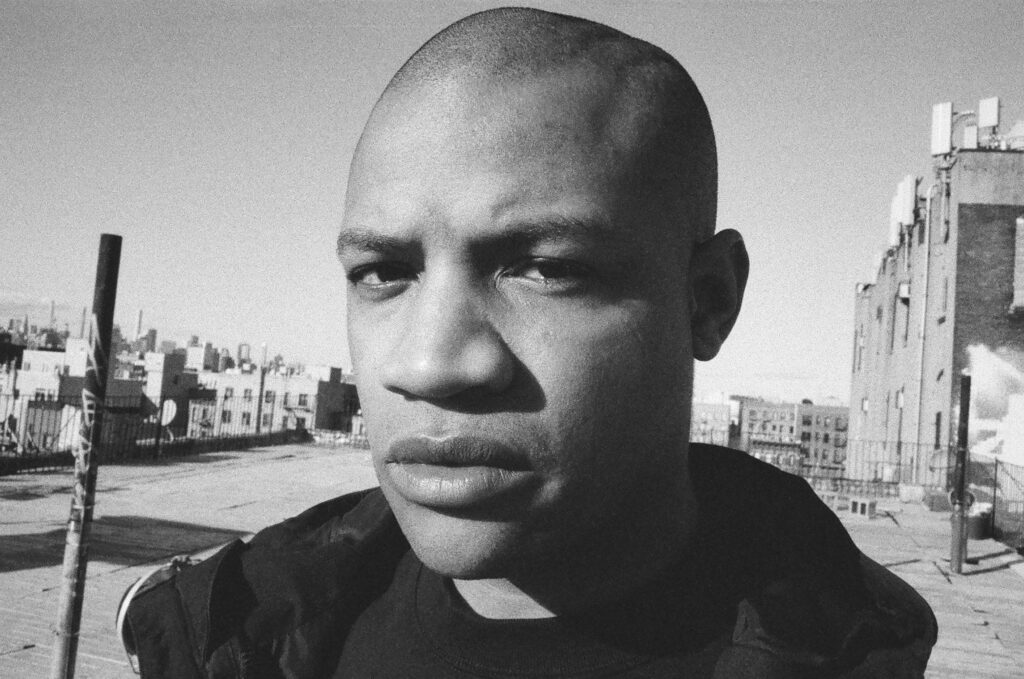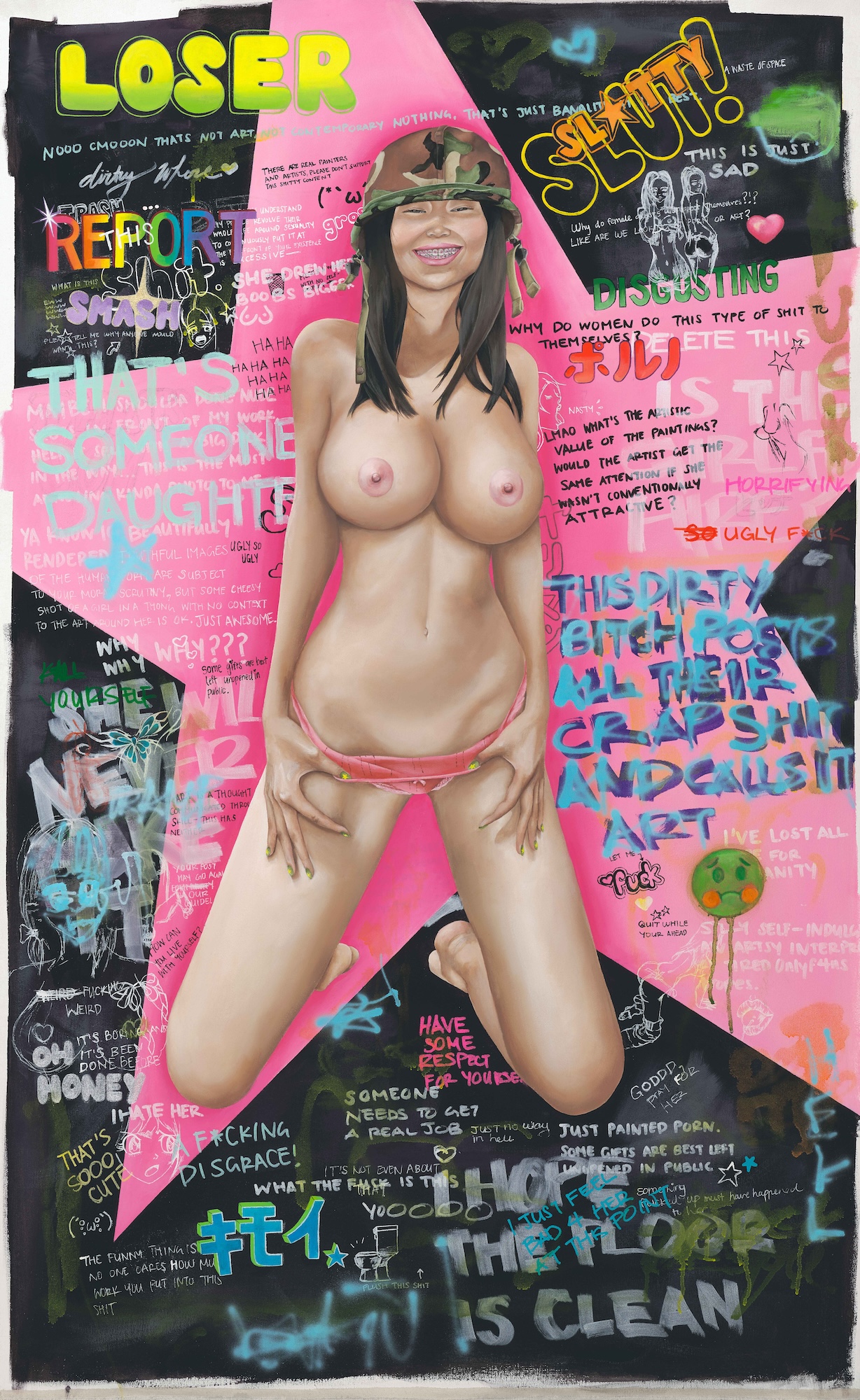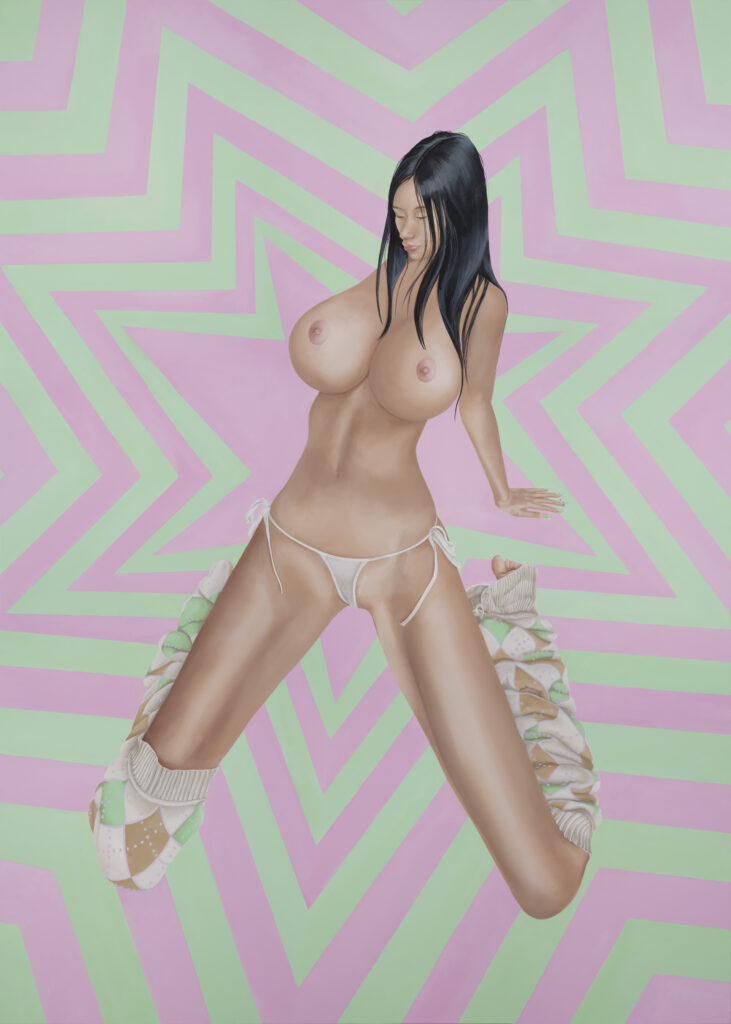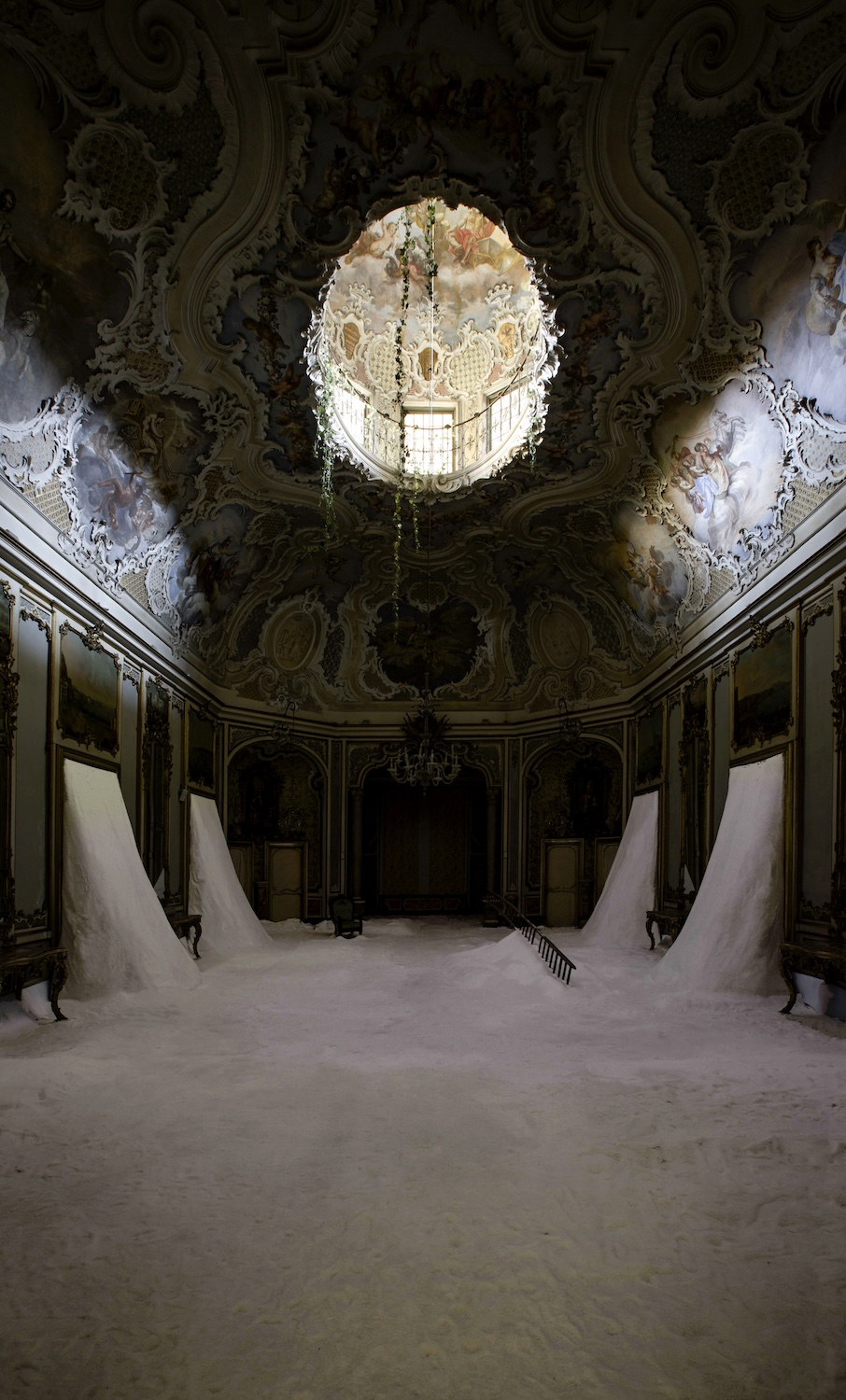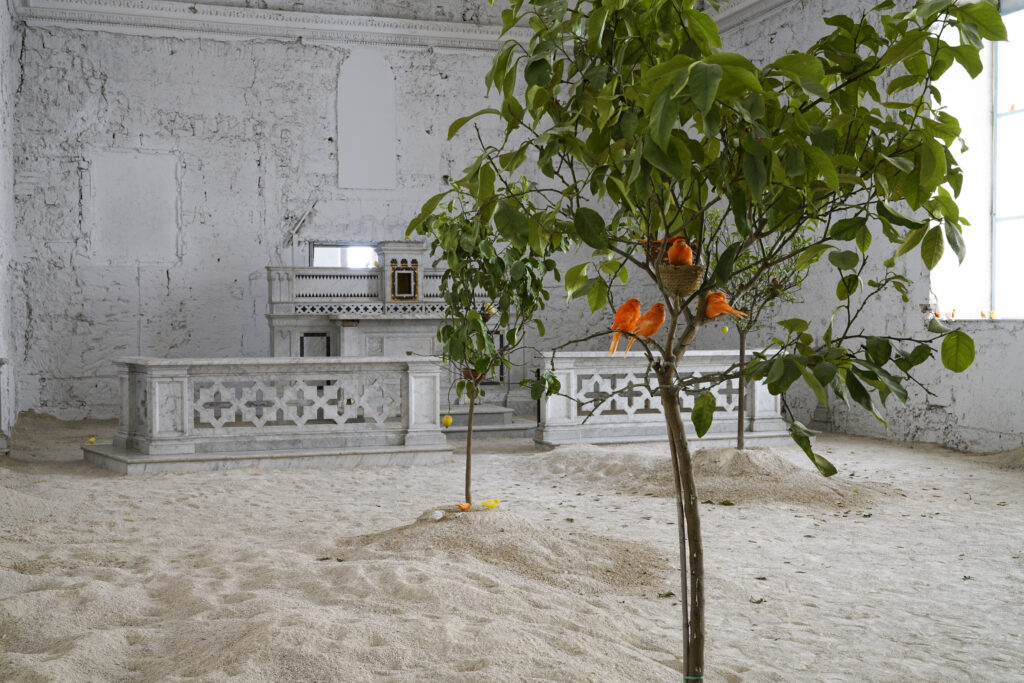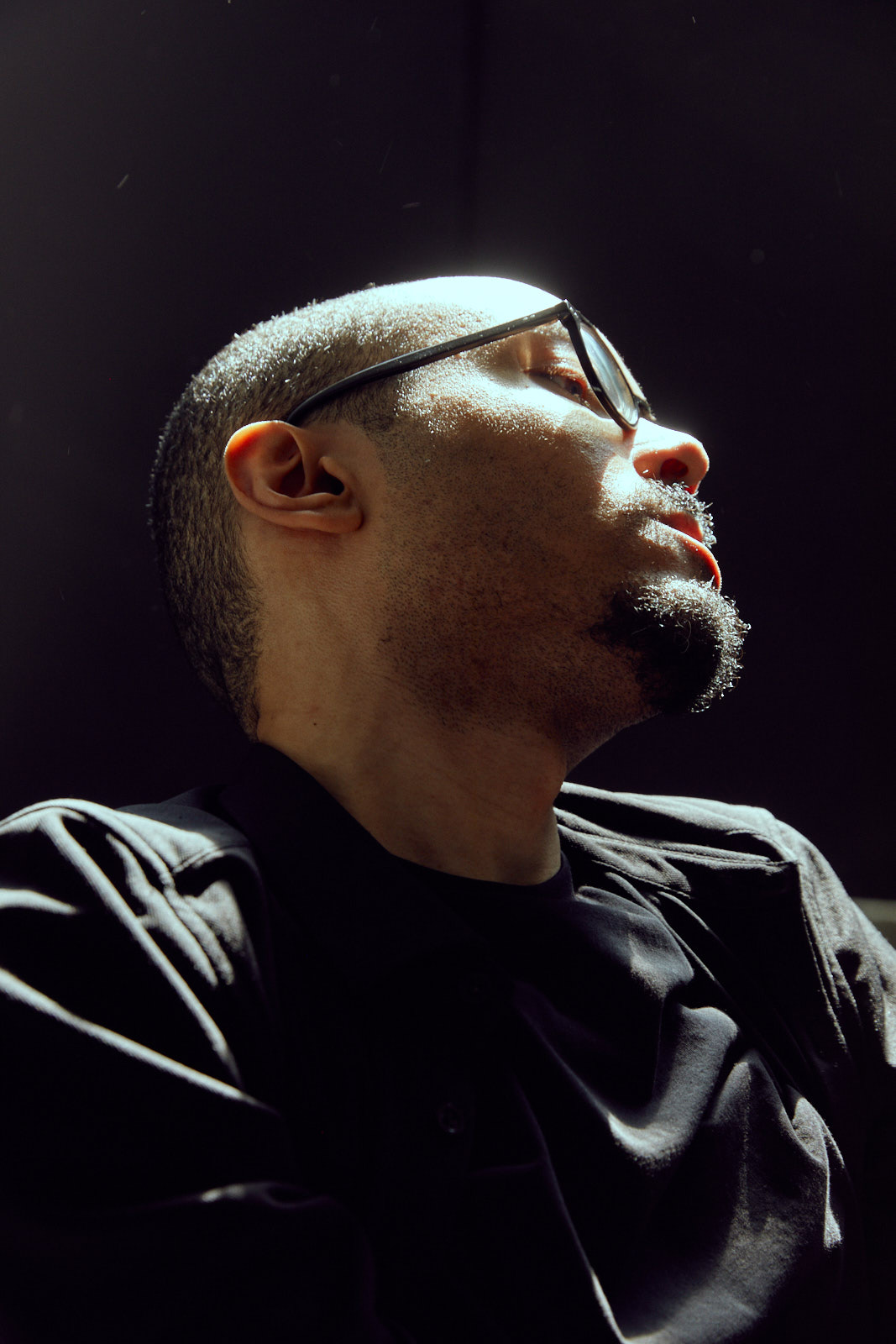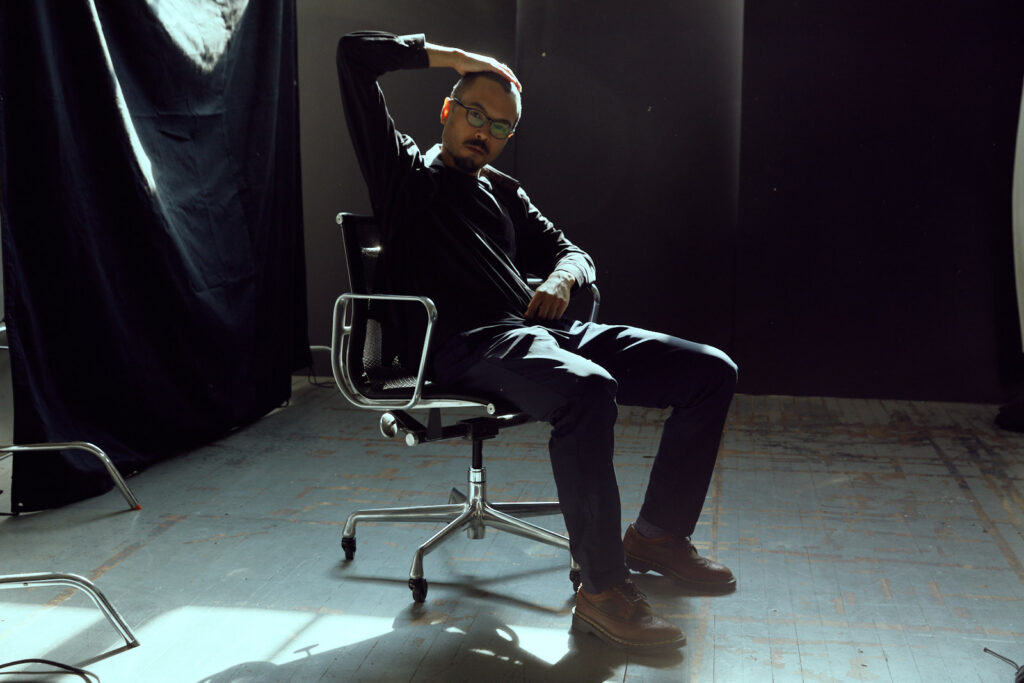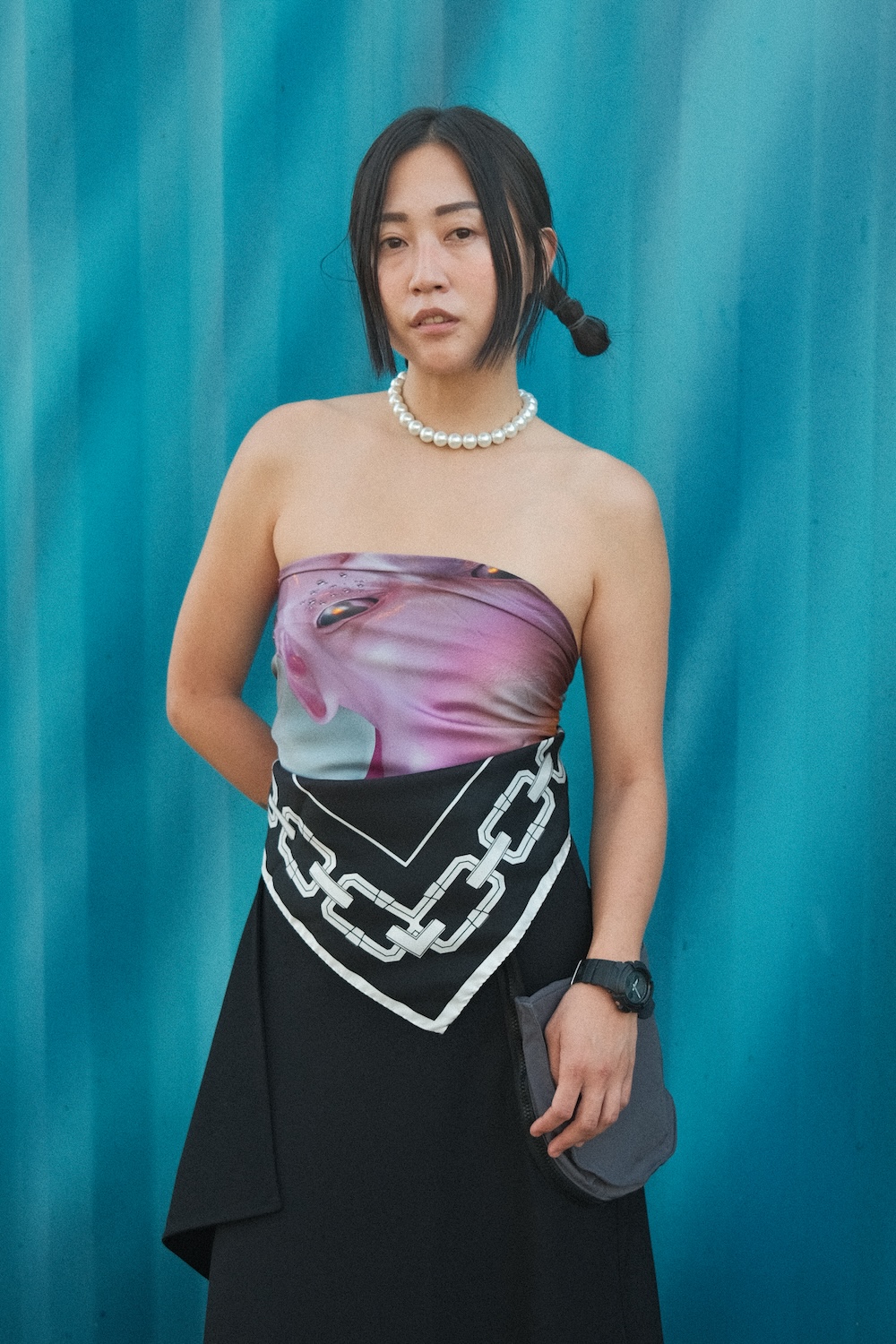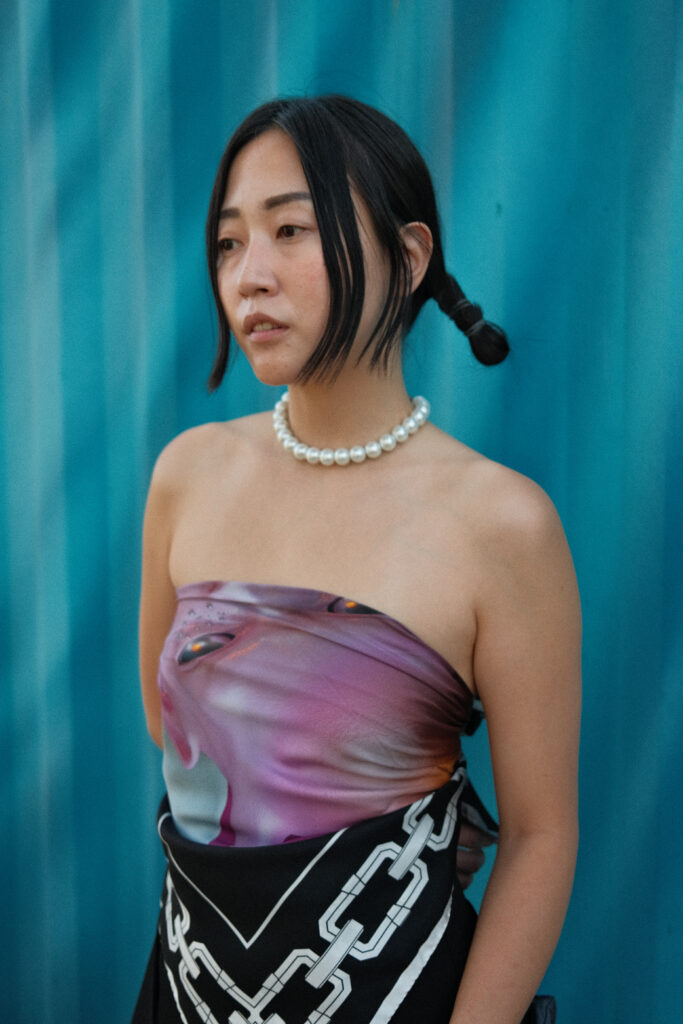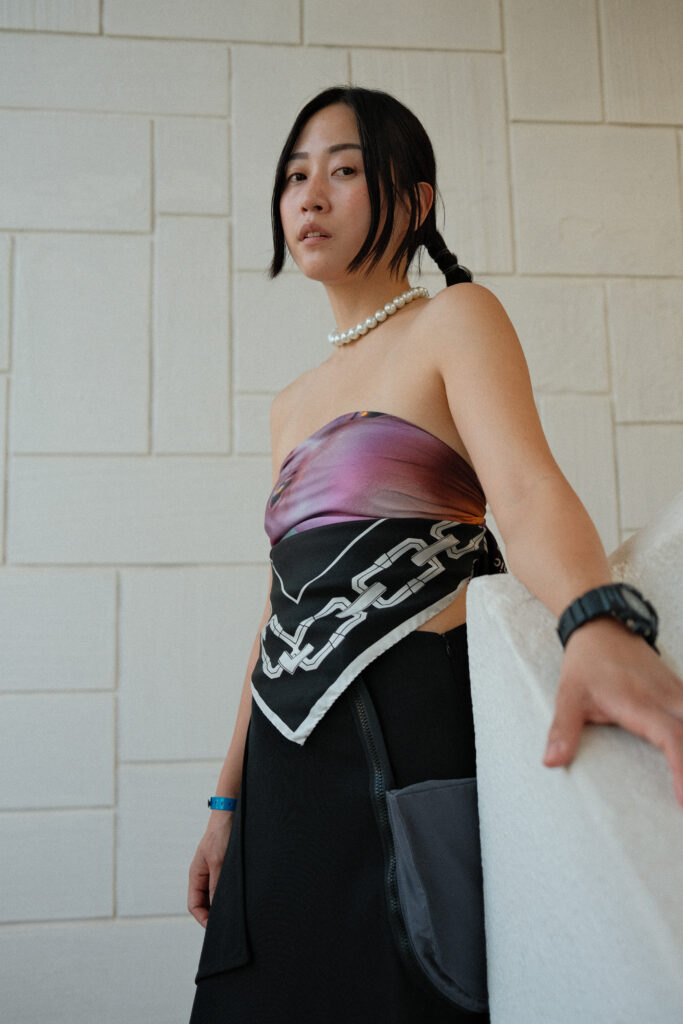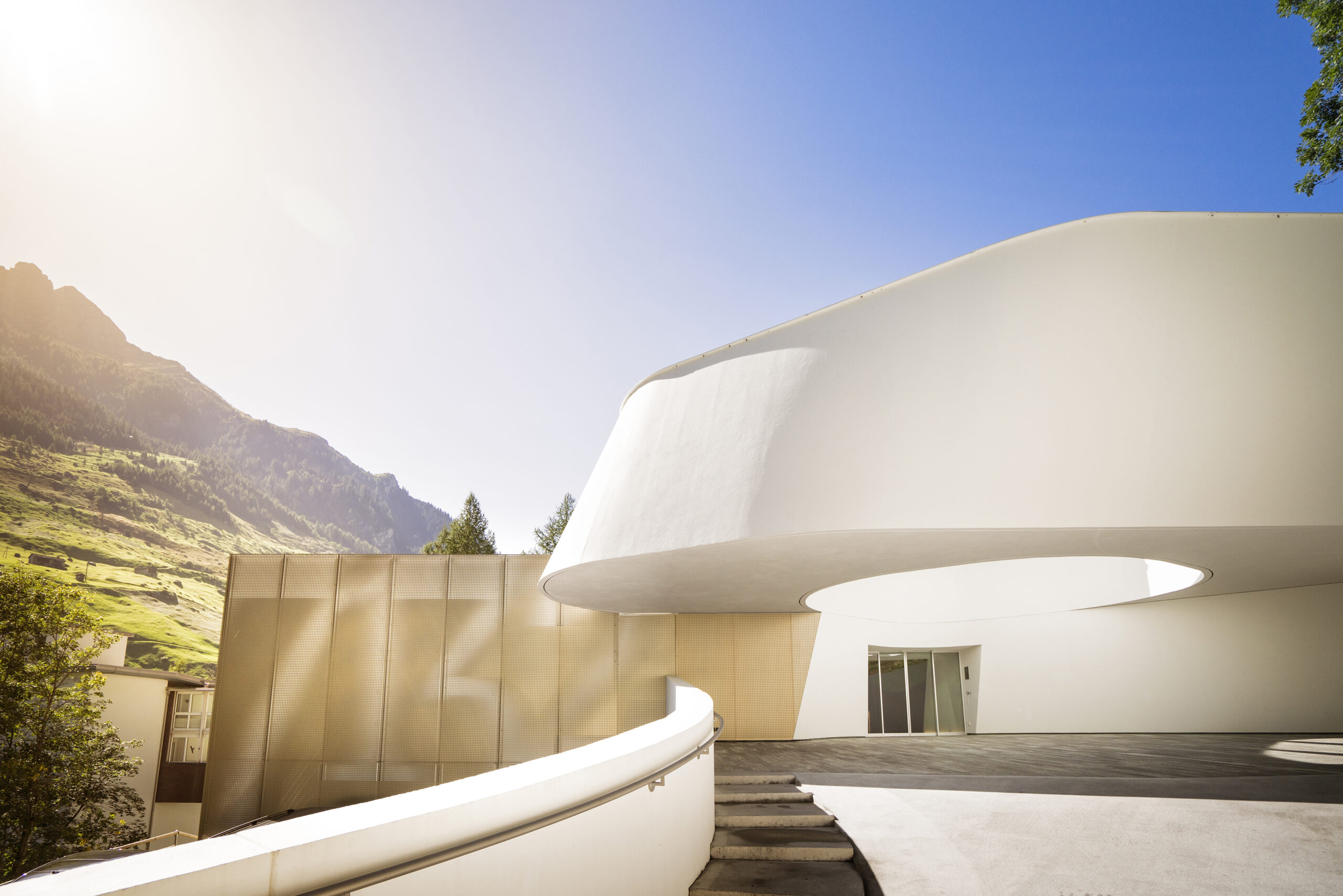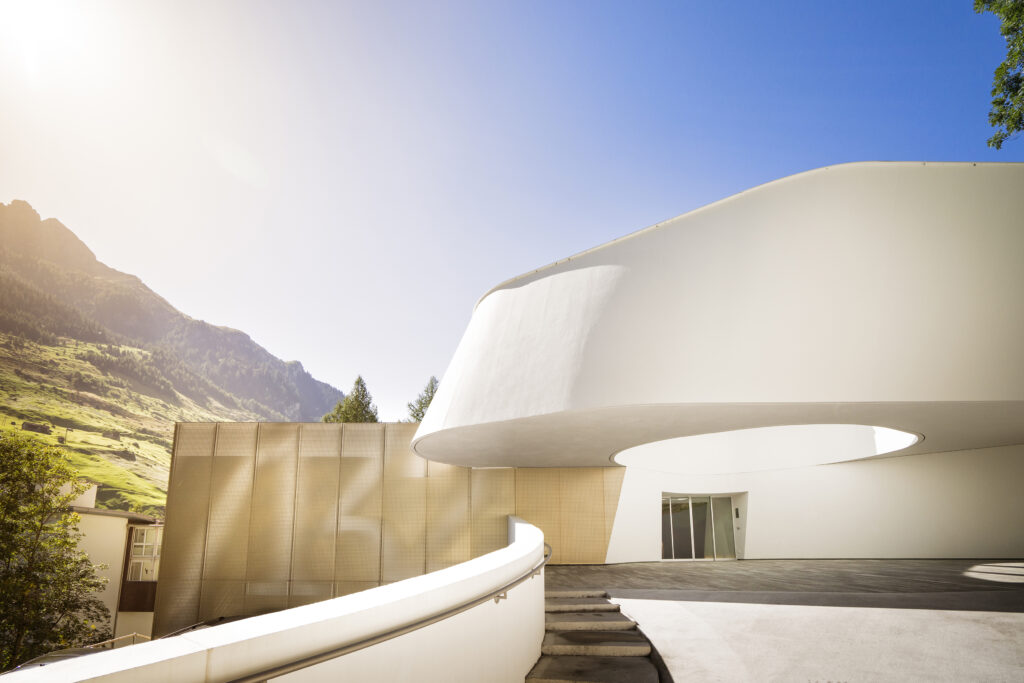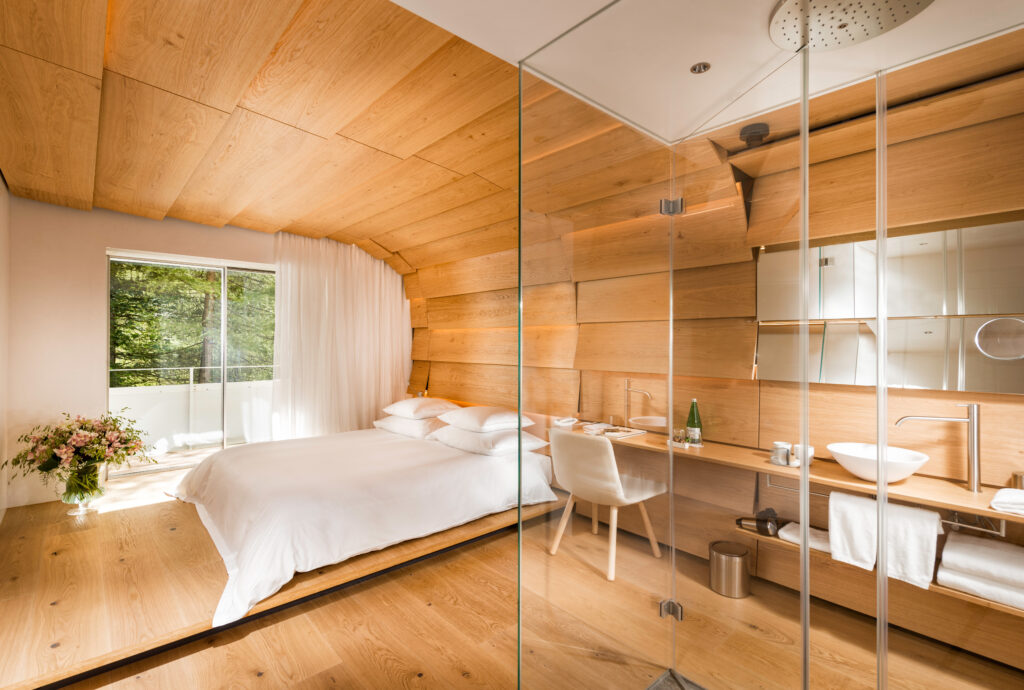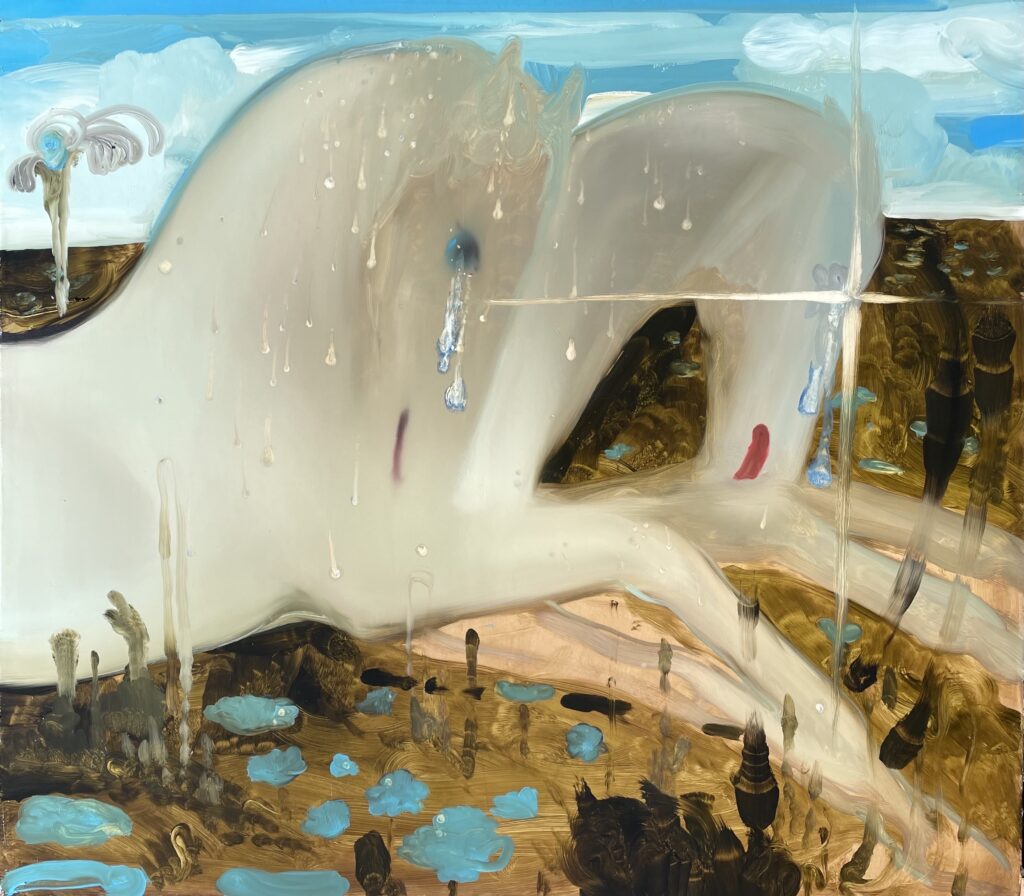
A Fraying Blur
At first glance: Things held within a cloud of pale air.
At second glance…
Rae Klein is tough. She has built a body of work that has received considerable praise. She was born in Michigan and is still there, working with a rhythm is respectable and representative of her success in recent years. Today, her role in this relationship is simple: she keeps producing. However, there is nothing desultory about this method. What Klein does is focus on the essential element of her life. Klein has always drawn but hasn’t always worked in oils. Before attaining her BFA, she planned to become a nurse. Before covering gallery walls, she shipped paintings out of her garage. Now, she has a studio. Oh, and she paints.
Folds and pleats of curtains separate from tense formality. Her constructions confront yet refrain from congesting the scene (they reference without any upturned noses or scoffs). The closest you’ll get to old-school is a bunch of candles resembling Corinthian columns or caryatids. Still, they are unsupported and unlikely to raise too many analogies to the ‘art of old’ — they are also clearly paintings of candles and candelabras. The source material is deliberate, and she paints it big and small.
The larger works are considered and organised by preliminary work. Smaller works are usually unplanned and texturally emotive, “If I’m going to sit down and do a painting, I’m going straight in, and I want to know that I can get it done in the session. I don’t want to get back to it later.” However, Klein’s paintings interreact simultaneously on both scales. Vector lines are established, and intense colours are formed. Pallid clouds interact with pairs of eyes in a spiralling stare. In the studio, she pulls up a painting with a horse head from the desk, and it immediately forms fantasies with a luminous white glow, breaking with the background through a plunged brush and sharp contrast. She makes paintings that can absorb hours of looking and hours of reading. As such, she leaves the sensuous appreciation to the viewer, briefing through a blur. Outlines are near perfect, sometimes muddied and obscured like a forest in fog. She restricts the number of brushes she uses, how long she works on her paintings, and how many finished works are produced in a month.
All in oils, the pigments bleed down like dyes, revealing painted imagery — or, more accurately, echoes of images — sourced from eBay, thrift or antique stores. Then, they are translated, and soon layers are raked in, and blue skies wrap backgrounds like Sistine Frescoes. Using a soft brush solvent for highlights and bursts of light (looking like lens flares from a JJ Abrahams film), Klein creates these marks by melting the paint while running the brush through the surface. The thinner paint draws (using a round brush) a glossy line or carves down (using a Filbert brush) to show the canvas base. “It’s just as important to move paint off the canvas as it is to put it on,” says Klein. The ground comes through like white tree roots, shining with a subtle radiancy. Like cutting away at curtains rather than parting them. But you can still see the paint, just differently.
Contemplating her practice, Klein observes her work through a tinted window, seeing a bit of herself inside but remaining outward-looking. Klein is introspective in her description yet makes her way across canvases with a tender distance. She’s focusing on the work and the process. In other words, she’s honest. She’s tough.
Billy De Luca: This is an early morning chat. It is 9:00 am. Where are we?
Rae Klein: In East Michigan. I live and work in a town called Grass Lake. It’s an hour south of Lansing (Michigan’s capital) and an hour north of Detroit. It’s like a village.
Billy De Luca: Have you always lived and had a studio here?
Rae Klein: No. I grew up across the State. Kind of by the lake, in Holland, Michigan. After school I moved, and I had been working from my garage in a town called Stockbridge for the past two years. I moved homes and the studio here in October 2022. It’s a cheap place to live, and it’s small.
Billy De Luca: And that must have been during the pandemic too. Did that affect the scale of your work?
Rae Klein: In those days, they were a lot smaller. They went from about 40 inches to now much bigger. My new studio’s ceiling is about 12 feet (four meters).
Billy De Luca: Does it feel better to have a gallery not to stress about the administrator?
Rae Klein: Oh yeah, absolutely. Shipping was always a doozy. Now a couple of dudes show up and pack ’em up. And that’s it. I think I just have to be there. So that’s amazing.
Billy De Luca: Do you stretch the canvases yourself? What makes them so smooth and glossy?
Rae Klein: No, I have a guy in Detroit who makes the canvases, and then I prime them myself. The canvases are all linen. I used to work on larger grain linen, but now I’m switching to a smaller grain. You can get a lot more detail that way. And the glossiness comes from the varnish. I varnish all the works so that I don’t touch them when they are done. Paintings can be overdone so quickly. It takes a lot of self-discipline to let it be the way it is. Some of them are smooth sailing. Others are ‘problem children’. The ones that are more of a struggle involve more problem-solving. I put them in a ‘time-out’ pile I have in the studio of works that are sitting. Eventually, I figure it out. That’s one of the fun parts of working: when it clicks. Then, knowing what to do.
Billy De Luca: How do you find painting in oils? Does it force you to have patience?
Rae Klein: All the work up here in the studio is drying…waiting. The oils help. But I still get impatient, and mistakes happen. I’m trying to apply a technique for controlling errors. Some mistakes will cause beautiful results, especially with textures and colours. But other mistakes have to be sorted into the ‘do not make again’ pile, for instance, getting perspectives wrong and disturbing the image or technical stuff like messing up the surface while priming. Learning to control my mistakes is a big part of improving.
Billy De Luca: And when it comes to your colour selection, do you create your own palette of pigments, or do you mix it up a lot?
Rae Klein: I do a lot of mixing. I’m really into earth tones, but it depends. If something is more mechanical and doesn’t have people, animals, or candles, it probably won’t beg for earth tones. But with my paintings that feature more organic matter, I’m squeezing those browns in!
Billy De Luca: And what makes you select your imagery and subject matter?
Rae Klein: That’s always been a tough one to answer. Basically, I think that they are just things I like. That feel timeless. I’m also now realising that they are also liminal: they could be from any place at any time. I think that’s interesting to play with.
Billy De Luca: You’re right, temporally communal. They are not bordered by specific contextual zones like Jasper Johns’ American Flag or a Gerhardt Richter scene of Paris. It’s tailored to a broader audience.
Rae Klein: And it’s not that I’m trying to cast a wide net. I’m glad I’m not thinking about that when I’m painting, but I do like the idea of having people relate to the imagery as if they might have seen it before. In the design phase, when constructing a painting, I’m looking for it to be a little new to me. I’m always trying to play around with it. I want it to strike me as if I’ve just discovered something. I think how I sketch them allows me to play with the idea a lot. The more rigid paintings are constructed much more like collages, and that’s also where I get some excitement. For some paintings, I just sit down and…do. And that’s a whole other thing. When it comes to the physical act, it has a lot to do with texture. It is equally important to fill the painting with exciting textures and marry it with itself. I get several types of enjoyment from different processes.
Billy De Luca: So, one process generates novelty, and the other comes naturally. Would you say that’s how you started making art?
Rae Klein: When I started painting, I was adding a lot of detail to the work. I felt like excitement would come from being very descriptive. Now I’m trying to see if I can leave more out. Like, what if I could just paint a curtain in an exciting and impactful way but also in a way that doesn’t involve planning out the whole scene? I think the exciting part for me right now is saying more with less. That’s the broad journey.
Billy De Luca: I love that. It’s interesting how acts of omission can further the quality of a work. And when you do it well, it feels much better. Like when somebody finds something interesting in your work that you didn’t have in a CV or portfolio.
Rae Klein: Yes! And I’m trying to apply that to my figures. I almost want them not to be a specific person. I want them to be a representation of a person. It doesn’t need a face or even eyes. It can be just one thing. I like setting the tone with objects.
Billy De Luca: I also noted that the smaller paintings involve outlines that come over and into the surface, like a finger through wet sand. They streak into the layers, muddying the paint and allowing the earth tones to spring up. Is that an example of a finishing touch or how your paintings are conducted within a session?
Rae Klein: Oh yeah, that’s both. I use a brush for that, and it’s very difficult to do on the large ones because it takes so much time to fill in an area. And it has to be done last because it marries the background and the foreground. The blend happens within the shapes and layers. I go over an area with the paint from the background to the main subject to ‘cohesify’ the image. Sometimes it creates a more interesting pattern, colour or line; other times, I let the lines show to avoid overworking the painting.
Billy De Luca: What do you think gets people interested? Like a profound experience of art. Do you think people can just as quickly struggle to accept your work?
Rae Klein: When somebody tells me that it makes them cry. That’s when I’ve done a good job with the painting. I’m in Michigan, so most of my interaction with people besides openings is through Instagram. People are all surprisingly friendly. If they leave a comment, it’s supportive. But there have been times when somebody will go, “So, this is art?” But I don’t take my paintings seriously. I’m not heartbroken if that happens. I’m interested in how people see it.
Billy De Luca: So you are removed from your work?
Rae Klein: I think so, yeah. I don’t keep them. Once I’m done painting a work, it has done its job for me. Once it is done, it can go in a pile. The enjoyment comes from making it and learning, not the final result it extracts. I mean, I’m proud of them, but it is not like I am going to keep them. There are always more nuances to learn that come with painting. And they keep coming! So, it’s better to focus on learning and improving.
Billy De Luca: Has the way you’ve produced changed over time? You just got back from your honeymoon. How was it being away from the studio?
Rae Klein: I took a week and a half off. And I was like…WOW, what’s going on? I just love to paint. If I have free time, I think I could be painting. I just love it.Usually, I’m pretty consistent. It has been stable for the past two years, but the period in which I worked is now widening; when I started, I would ask myself what I could do on the day, and now it’s more about what I can do in the month and how I can plan the next six months. It was interesting because I have always had a schedule, and when I started supporting myself with my work, I would make paintings available every month or two. That schedule is different in the timespan from the gallery schedule, so it has changed, and I’m structuring it a lot more.
Billy De Luca: And who would you say is your toughest critic?
Rae Klein: Good question. The gallery has really helped me grow and become comfortable with talking about my work. Nicodim is great because they are selective with their artists, but I still have creative control. It’s not always like that with other galleries. When it comes to advice, I think it’s probably my husband. I go to him with a problem, and he’ll be honest, and that’s good.
Billy De Luca: What affects your style?
Rae Klein: My method involves a lot of images too, and they are mostly found. I get a lot from that. Then comes the process of making it interesting for myself. I think style is ever-evolving and something that’s in the rear-view mirror. I figure it will continue to change since I’m on a learning journey, and that’s where the enjoyment is for me. Looking back, it seems pretty fluid, but I’ve been told it is pretty consistent. Some people see it that way, but I see it differently.
Billy De Luca: What would be something you’d always like to keep in your paintings? Is there more to add?
Rae Klein: The first thing that comes to mind is that I don’t see the dogs or the horses going away. I’ve been drawing horses since I was a little kid. I wasn’t a ‘horse girl’ but I did love horses. As a kid, I wasn’t allowed anywhere near horses, so I had to draw them. I used to paint cars, and as I learned more, I realised it wouldn’t fit, and those got phased out. I don’t think how I get images or anything like that will change. That’s always been pretty consistent. I do want to keep up with technology, though. Trying to learn about AI generation and digital resources is very important, especially how to use that stuff. If you start to fear it, it can cause stagnation in learning, especially since that is where the momentum is taking us. So I’m concerning myself with that right now, and it’s definitely interesting to learn about. I don’t see myself integrating these new things very often, but I want to be aware of them and know how I could use them if I wanted, without having any judgement. I’m looking to coexist.
Credits
GEMINI,2021
IS THERE A BETTER MAN THAN I, 2023
SONDRA IV, 2023
CASCADES II, 2021
All artworks courtesy of Rae Klein and Nicodim Gallery
